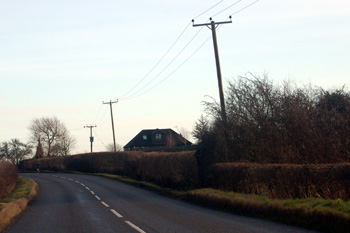Stanbridge Brickworks

Far Fields, the site of one of the Stanbridge brickworks December 2008
The Rating and Valuation Act 1925 ordered every building and piece of land in the country to be assessed to determine the rates to be paid on it. Stanbridge was assessed in 1927. At that date the parish contained two brickworks. Both of these stood along the Leighton Road. The first was at Midway, immediately west of the present [2008] Leighton Buzzard Rugby Club ground. The other was on the opposite, south, side of the road where the modern house called Far Fields stands.
The valuer noted that the works at Midway [DV1/C97/65] belonged to the executors of T.Yirrell and comprised 4.079 acres. He noted: "Saw Mr.Cleaver, Foreman". The ground consisted of three feet of topping which, when removed, exposed the clay layer "Clay out of horizontal so cost more to dig out" the foreman explained. The works employed ten men and in 1924 had made 500,000 bricks and pipes, the same number in 1925 but only 400,000 in 1926 due to a coal strike (part of the famous General Strike which ten days, from the 3rd to the 13th May). Despite this production was "probably increasing". A new engine had been installed in 1926 and the site had two kilns, the valuer noted, logically, "could double output and sell them if two more kilns". Other buildings comprised a weather boarded and corrugated iron drying shed, a brick and corrugated iron engine shed, a brick, weather boarded and corrugated iron workshop and mess room and machine sheds.
The works on the site if Far Fields [DV1/C97/55] was owned and occupied by L.B.Faulkner and comprised 4.078 acres. The valuer "saw Foreman Mr.Ward". Here the soil extended five feet down before the clay was reached and the site employed two men in winter and five or six in summer. All the bricks were wire cut and two kilns were in use, a further, circular kiln being unused. Buildings comprised a weather boarded and corrugated iron stable, a small men's hut [!], a large brick, weather boarded and corrugated iron drying shed and store and a weather boarded and corrugated iron engine shed as wel las a shed over pipe and brick machines. No production figures are noted.